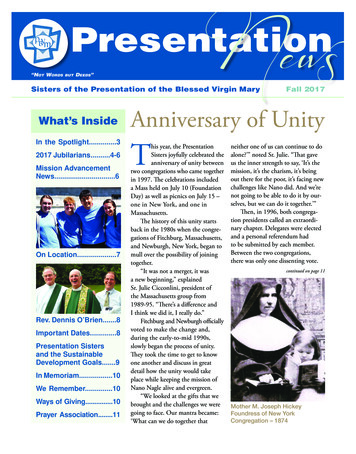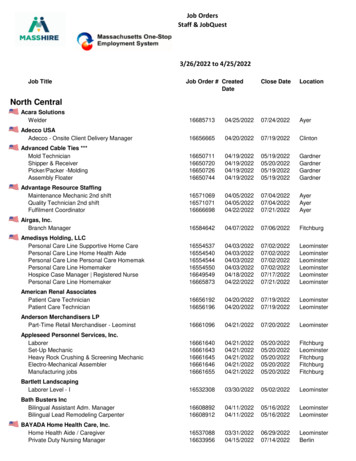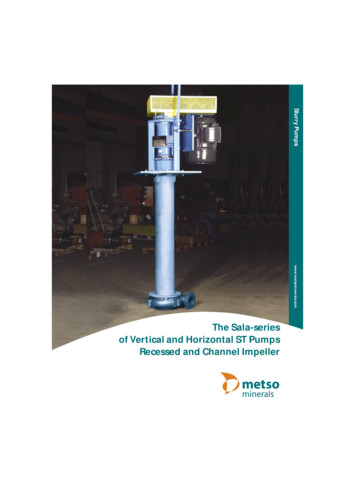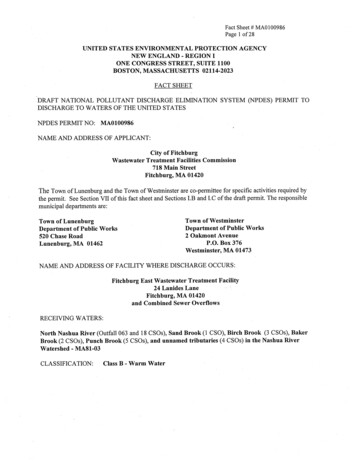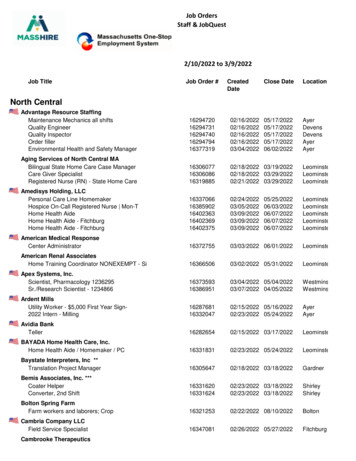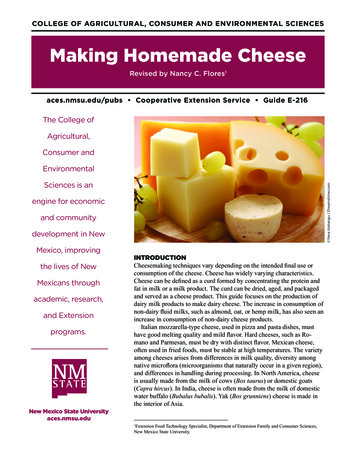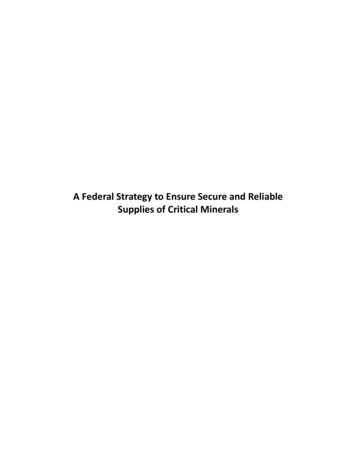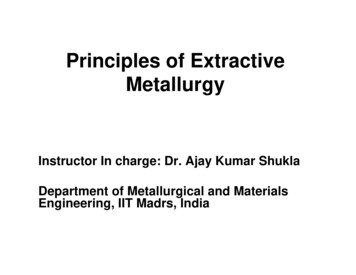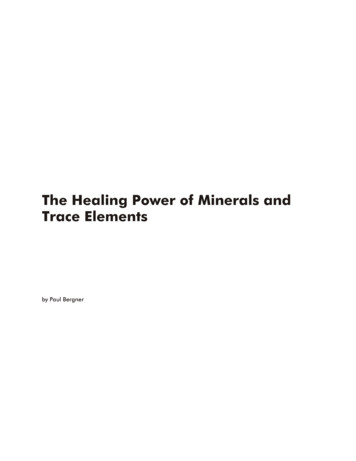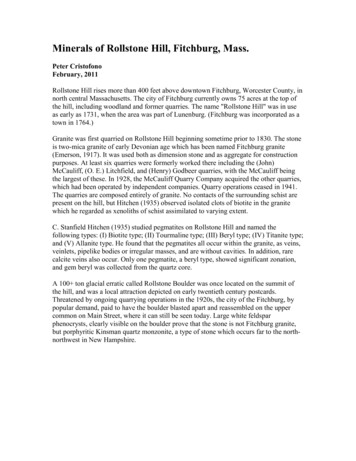
Transcription
Minerals of Rollstone Hill, Fitchburg, Mass.Peter CristofonoFebruary, 2011Rollstone Hill rises more than 400 feet above downtown Fitchburg, Worcester County, innorth central Massachusetts. The city of Fitchburg currently owns 75 acres at the top ofthe hill, including woodland and former quarries. The name "Rollstone Hill" was in useas early as 1731, when the area was part of Lunenburg. (Fitchburg was incorporated as atown in 1764.)Granite was first quarried on Rollstone Hill beginning sometime prior to 1830. The stoneis two-mica granite of early Devonian age which has been named Fitchburg granite(Emerson, 1917). It was used both as dimension stone and as aggregate for constructionpurposes. At least six quarries were formerly worked there including the (John)McCauliff, (O. E.) Litchfield, and (Henry) Godbeer quarries, with the McCauliff beingthe largest of these. In 1928, the McCauliff Quarry Company acquired the other quarries,which had been operated by independent companies. Quarry operations ceased in 1941.The quarries are composed entirely of granite. No contacts of the surrounding schist arepresent on the hill, but Hitchen (1935) observed isolated clots of biotite in the granitewhich he regarded as xenoliths of schist assimilated to varying extent.C. Stanfield Hitchen (1935) studied pegmatites on Rollstone Hill and named thefollowing types: (I) Biotite type; (II) Tourmaline type; (III) Beryl type; (IV) Titanite type;and (V) Allanite type. He found that the pegmatites all occur within the granite, as veins,veinlets, pipelike bodies or irregular masses, and are without cavities. In addition, rarecalcite veins also occur. Only one pegmatite, a beryl type, showed significant zonation,and gem beryl was collected from the quartz core.A 100 ton glacial erratic called Rollstone Boulder was once located on the summit ofthe hill, and was a local attraction depicted on early twentieth century postcards.Threatened by ongoing quarrying operations in the 1920s, the city of the Fitchburg, bypopular demand, paid to have the boulder blasted apart and reassembled on the uppercommon on Main Street, where it can still be seen today. Large white feldsparphenocrysts, clearly visible on the boulder prove that the stone is not Fitchburg granite,but porphyritic Kinsman quartz monzonite, a type of stone which occurs far to the northnorthwest in New Hampshire.
Quarry view — early 20th century postcardModern view of McCauliff QuarryTwo old postcard views of Rollstone Boulder, ca. 1910Minerals Twenty-nine minerals have been reliably reported from Rollstone Hill. Twoothers are considered unconfirmed, and three more are reported here as unidentified.Albite NaAlSi3O8Albite microcrystals occur in calcite veins (Hitchen, 1935), and also as a late mineral associated withmicrocline in the pegmatites. The variety, oligoclase, (Na,Ca)[Al(Si,Al)Si2O8] occurs as a primarymineral (as anti-perthite) in phenocrysts in “Type II” pegmatites (Hitchen, 1935) and was also noted byDale (1910, 1923), Emerson (1917) and Hurlbut (1964).Allanite-(Ce) (Ca,Ce,Y)2(Al, Fe2 , Fe3 )3(SiO4)(Si2O7)(O)(OH). Epidote Group.Allanite occurs as dark green or brown to black crystals, superficially weathering toorange or dark red-brown. Crystals can be several centimeters in length and mostly occurin the “Type V” pegmatites. Two SEM-EDS analyses (this study) show that cerium is thedominant rare earth element, followed by appreciable Nd. The mineral is radioactive dueto thorium content. Crystals are frequently curved. “Gummite” was reported by Emerson(1917) as an alteration product of allanite; Hitchen (1935) reported seeing an orangecolored metamict substance fringing the crystals (in thin sections). Allanite was alsoreported by Lewis (1927), Lane (1933), Kitson (1938), Billings (1941), Bjareby (1962),Hurlbut (1964), Seaman (1976), Grauch & Zarinski (1976), and listed in Gleba (1978) asthe variety “orthite.”
Allanite-(Ce) FOV 8mmAllanite-(Ce) 3mm crystalAllanite “Type V” Pegmatite showing weathered allanite crystals in quartz. FOV is about 30cm.Almandine (Fe,Mn)3Al2Si3O12 Garnet Group.Manganese-rich almandine occurs in crystals in Type III and IV pegmatites. Garnet alsooccurs as an accessory in granite. Color can be shades of red, orange or pink. Pinkcrystals are associated with micro brown schorl in muscovite variety “sericite.” Orangered to red crystals, showing a combination of the dodecahedron and the trapezohedron(according to Hitchen, 1935), can be up to 2cm in diameter. The smaller ones arefrequently transparent and gemmy. Hitchen (1935) reported an analysis showing a largespessartine component to the pegmatite garnet, and SEM-EDS (this study) of an orangered crystal also shows high Mn content though still subordinate to Fe. (See also the entryfor spessartine.)“Garnet” was also reported by Dale (1910, 1923), Lewis (1927) and Hurlbut (1964);“red garnet” by Emerson (1917); “almandine” or “almandite” by Bjareby (1962) andGleba (1978).
Almandine 1.5mm crystalAlmandine (pink) and Schorl (brown) FOV 1mmArsenopyrite FeAsSSulfides are uncommon on Rollstone Hill; Hitchen (1935) reported that arsenopyrite isthe most common.Arsenopyrite 3mm crystalArsenopyrite 1.5mm crystalAutunite Ca(UO2)2(PO4)2·11H2OAutunite was reported by Grauch & Zarinski (1976). Not observed in the present study.Beryl Be3Al2(Si6O18)Gem beryl has been reported from Rollstone Hill, mostly the golden variety. The earliestreport was by Hamlin (1870) who stated: “At the quarries at Fitchburg, beryl of a richgolden hue, approaching the chrysoberyl and topaz in color and hardness, and closelyresembling the yellow diamond in lustre, have been blasted out.” Yellow or golden berylwas again reported by Hamlin (1873) and also by Burbank (1879), Schaller (1918), andMcCaskey (1919). Aquamarine was reported by Emerson (1917). Hitchen (1935) notedthat beryl colors range from pale green to deep golden yellow. Most crystals are non-gemquality and occur in the “Type III” beryl pegmatite. Some crystals are offset and “healed”by quartz. The “Type III” pegmatite was observed in place (this study), and in nearbyquarried boulders where very pale green beryl was observed frozen in matrix. Beryl isinfrequently found now that the quarry has been inactive for so long. Nevertheless,mineral collector Mike Shih of the Boston Mineral Club discovered a new occurrence ofcolorless to pale green crystals in a small boulder in 2010 (photo, below right).
Beryl 26.5mm crystal(Harvard Mineralogical Museum) Beryl 4mm “goshenite” crystalBeryl 72mm crystal, collected in 1915(Harvard Mineralogical Museum)“Biotite” is a general name for a dark mineral of the Mica Group.Biotite occurs in “Type I” pegmatites in plates up to an inch in diameter (Billings, 1941),where it is associated with microcline, albite, muscovite and minor magnetite. It alsooccurs with muscovite in granite. Hitchen (1935) reported refractive indices whichsuggested that this black mica may be the mineral siderophyllite,KFe2 2Al(Al2Si2)O10(F,OH)2. Biotite was also reported by Dale (1910, 1923), Emerson(1917), Kitson (1938), Billings (1941) and Hurlbut (1964).
Biotite FOV 10mmCalcite CaCO3Massive calcite occurs rarely in veins, enclosing microcrystals of quartz, muscovite,albite, chamosite, titanite, ilmenite and fluorite. Calcite veins were described by Hitchen(1935).Chalcopyrite CuFeS2Hitchen (1935) noted chalcopyrite crystals associated with pyrrhotite.Chalcopyrite FOV 0.75mmChamosite (Fe2 , Mg)5Al(AlSi3O10) (OH) 8 Chlorite Group.Chamosite is dark green and is found with ilmenite and titanite in calcite veins and as analteration of biotite in “Type II” and “Type IV” pegmatites. “Chlorite” was reported byDale (1910, 1923) and Hitchen (1935). “Prochlorite” was listed by Seaman (1976). SEMEDS analysis (this study) of a dark green chlorite mineral from a calcite vein proved to bechamosite.
Chamosite (green) with Ilmenite FOV 2mmChamosite on Muscovite FOV 2mmChamosite (green); Titanite (pink-tan); Quartz (colorless) FOV 2.5mmColumbite(?)Columbite was listed by Kitson (1938), Billings (1941), Grauch & Zarinski (1976) andGleba (1978). No specimen or analysis known; may be misidentified ilmenite.Epidote Ca2Al2(Fe3 ;Al)(SiO4)(Si2O7)O(OH)Epidote was reported by Dale (1910) as a secondary mineral in granite.Fluorapatite Ca5(PO4)3FApatite was reported by Hitchen (1935) as a “very rare” mineral occurring in crystals upto 2.5 cm long in the “Type III” beryl pegmatite, and as an accessory in the “Type IV”veins. In the present study, it has also been found in the Type II pegmatites, where it isfrequently light gray in color and can be difficult to distinguish in the field from quartz.The fluorapatite occurs in simple hexagonal crystals, light gray, colorless or very palegreen or greenish yellow, and exhibits strong yellow fluorescence under SW ultraviolet
light. Apatite was also reported as an accessory in granite by Dale (1910, 1923) andHitchen (1935).Fluorapatite 9mm crystalFluorapatite 2mm crystalFluorite CaF2 occurs as colorless or purple cubic microcrystals in calcite veins (Hitchen,1935).Fluorite FOV 0.5mmIlmenite Fe2 TiO3Black crystals of ilmenite occur in “Type II” and “Type IV” pegmatites and in calciteveins, sometimes superficially weathering to a bluish color. Ilmenite was noted byHitchen (1935), Kitson (1938), Bjareby (1962) and listed by Gleba (1978).
Ilmenite 1mm crystal on TitaniteIlmenite 1mm crystal in Calcite with Ilmenite-included Quartz crystalMagnetite Fe3O4Magnetite was reported by Hitchen (1935) as microscopic grains associated with biotitein the “Type I” pegmatites.Marcasite FeS2Marcasite was seen by Hitchen (1935) in polished section, occurring as concretionarymasses resulting from supergene alteration of pyrrhotite.Microcline KAlSi3O8Microcline occurs as a component of microperthite in granite and pegmatite. Crudecrystals occur on the walls of “Type II” pegmatites, while more perfect crystals, mostlyCarlsbad twins, up to 8 cm long occur embedded in massive quartz (Hitchen, 1935).Microcline was also reported by Dale (1910, 1923), Emerson (1917), Lewis (1927),Bjareby (1962) and Hurlbut (1964).Microcline 20mm crystalMolybdenite MoS2Molybdenite was reported by Hitchen (1935) as a rare mineral in fissures in the “TypeIV” (beryl) pegmatite, associated with sericite and garnet.
Muscovite KAl2AlSi3O10(OH)2 Mica Group.Muscovite occurs in all pegmatites except “Type V” and in the “Type III” plates may beup to 4 cm across (Hitchen, 1935). It also occurs in granite and as perfect pseudohexagonal crystals in calcite veins; also found as the fine-grained variety “sericite” inseams, associated with micro garnet and schorl. Muscovite was noted by Emerson(1917), Dale (1923), Kitson (1938) and Hurlbut (1964). Very rarely a pink variety, socalled “rose muscovite,” occurs in feldspar in pegmatite. This color variety was firstnoted by Carl Francis (pers. comm., 2010) on a Harvard Mineralogical Museumspecimen; subsequently it was found as a rounded 2mm fine-grained aggregate (thisstudy). Heinrich and Levinson (1953) attributed the color of specimens of rose muscovitethey studied from various localities to the absence of Fe2 and the dominance of Mn overFe3 . Though not a factor in the color, the examples they studied contained a smallamount of lithium and occurred in replacement units in zoned pegmatites. The cause ofthe color in examples from Rollstone Hill remains to be resolved.Rose Muscovite 5mm crystal (Harvard)Muscovite crystals and Chamosite (green), in Calcite FOV 3mmOpal (v. hyalite) SiO2·nH2OThis mineral was noted (this study) as strongly fluorescent (green, SW) colorless coatingson feldspar.Orthoclase KAlSi3O8Orthoclase was reported (as distinct from microcline) by Emerson (1917), Dale (1923)and Hurlbut (1964) as a component of granite.Pyrite FeS2Surprisingly rare on Rollstone Hill, this mineral was only seen once in this study — as anapproximately 0.25mm modified cubic crystal, associated with much smallerchalcopyrite crystals and radial “sixling” twins of arsenopyrite.
Pyrite 0.25mm crystalPyrite, Arsenopyrite, Chalcopyrite FOV 0.75mmPyrrhotite Fe1-x S (x 0 to 0.17)Pyrrhotite was reported by Hitchen (1935) as the second most common sulfide, afterarsenopyrite.Pyrrhotite 0.25mm crystalQuartz SiO2Quartz is almost always massive except for the nearly colorless crystals which occur incalcite veins. The massive quartz of the pegmatites is generally a light smoky color.(Dale, 1910, 1923; McCaskey, 1919; Hitchen, 1935; Bjareby, 1962)
Quartz 1mm crystalQuartz in Calcite 2mm crystalRutile TiO2Rutile was reported in granite as micro-needles in quartz, albite and microcline (Dale,1910, 1923; Emerson, 1917).Schorl Na(Fe2 3)Al6(Si6O18)(BO3) 3(OH) 3(OH) Tourmaline Group.Schorl occurs abundantly in “Type II” pegmatites, sometimes in fine black crystals up toseveral inches in length. It also occurs in the “Type III” beryl pegmatite and as anaccessory in granite. Schorl, or black tourmaline, is the most collectible mineral atRollstone Hill and is included in all prior lists of minerals from the locality. Hitchen(1935) described crystals that had been horizontally fractured and rehealed by quartz andfeldspar, and crystals with quartz cores occurring along a vertical axis. He also notedschorl occurring as sooty aggregates of minute crystals; in graphic intergrowth withquartz (similar to some pegmatites in New Hampshire and Maine); and as groups ofradiating crystals. A large and outstanding specimen of these radiating or "sunburst"schorl crystals is in the collection of the Harvard Mineralogical Museum. Schorl is alsofound as clusters of secondary translucent green-brown microcrystals on feldspar.
Schorl 11mm crystalSchorl with Quartz core 12mm crystalSchorl, green-brown; FOV 1mm
Tourmaline “Type II” Pegmatite (US quarter coin for scale)Siderophyllite (?) Mica Group. See entry for biotite.Spessartine (?) (Mn,Fe)3Al2Si3O12 Garnet Group.Spessartine has not been verified, but is strongly suspected to occur as rare yellow toorange crystals and zones within crystals (this study). Hitchen (1935) reported an analysisof carefully selected garnet samples which were found to contain about 42% spessartinecomponent and 53% almandine component. A garnet with more than a 50% spessartinecomponent would by definition be considered spessartine.Garnet crystals with yellow to orange areas, probably Spessartine; FOV 3mm
Titanite CaTiSiO5Titanite occurs in brown crystals up to 2 cm long in “Type IV” pegmatite veins (Hitchen,1935); also noted as pinkish-tan crystalline aggregates associated with chamosite incalcite veins. Titanite (“sphene”) was mentioned as occurring in “good crystals” bySeaman (1976). Hitchen suggests that titanite occurs as a replacement of ilmenite, withwhich it is frequently associated.Titanite 17mm crystalTitanite FOV 0.75mmUraninite UO2This mineral was reported by Lane (1933) who observed a 4mm sample, but was not seenby Hitchen (1935) or in the present study. Lane reported a uranium content of 50.2% inthe analyzed portion of the sample.Zircon ZrSiO4Hitchen (1935) reports zircon from “Type II” and “Type IV” pegmatites, and as anaccessory in granite. Sub-millimeter brown crystals were observed in the present study,associated with fluorapatite, almandine and ilmenite.Zircon 0.75 mm crystal
Other Minerals Not Yet IdentifiedUK-1A bright yellow mineral was found associated with pyrrhotite and chalcopyrite, as anapparent alteration product. Possibly native sulfur or a yellow iron sulfate mineral.UK-1 FOV 0.5mmUK-2Off-white, radial crystal aggregates with a crude hexagonal outline, much smaller than1mm, were found in association with allanite-(Ce). This mineral could be an alterationproduct of allanite-(Ce) such as the REE fluoro-carbonate, bastnäsite-(Ce).
UK-2 FOV 2mmUK-3White spheres were found in a fluorapatite-rich pegmatite vein associated withfluorapatite and schorl; possibly a clay mineral or a secondary form of apatite.
UK-3 FOV 4mmConclusionThough the quarries have been inactive for 70 years, Rollstone Hill continues to be asource of fine schorl crystals for the diligent collector. Continued investigation into itsmicrominerals has the potential to extend the species list of the locality, and to be animportant contribution to the mineralogy of Massachusetts and the New England region.REFERENCES- Astell, Emilie (1991): Putting the pieces together for a bit of Fitchburg history (Worcester Telegram &Gazette, NE edition, p. A-2. Dec. 16, 1991).- Billings, Marland P. (1941): Pegmatites of Massachusetts. (Prepared under a cooperative project forgeologic investigations in the Commonwealth of Massachusetts).- Burbank, L. S. (1879): in Proceedings of the Boston Society of Natural History (American Naturalist,Vol. 13, 1879).- Carter, James G. and William H. Brooks (1830): A Geography of Massachusetts (Boston: Hillard, Gray,Little and Wilkens), p. 146.- Dale, T. Nelson (1910): Supplemental Notes on the Commercial Granites of Massachusetts (USGSBulletin 470).- Dale, T. Nelson (1923): The Commercial Granites of New England (USGS Bulletin 738).- Dietrich, Richard V. (1985): The Tourmaline Group (NY: Van Nostrand Reinhold).- Emerson, B. K. (1917): Geology of Massachusetts and Rhode Island (USGS Bulletin 597).- Fitchburg Historical Society (2005): Fitchburg (Charleston SC: Arcadia Publishing).- Mass. Dept. of Conservation and Recreation (2006): Fitchburg Reconnaissance d/reconReports/fitchburg.pdf).- Gaines, R. V., et. al. (1997): Dana’s New Mineralogy, 8th Edition, p. 1264.- Gleba, Peter (1978): Massachusetts Mineral and Fossil Localities.- Gosse, Ralph (1969): A Catalogue of Massachusetts Gemstones, Part V, Worcester County (Rocks &Minerals 44:436-437).- Grauch, R. I., and Zarinski, Katrin (1976): Generalized descriptions of uranium-bearing veins, pegmatites,and disseminations in non-sedimentary rocks, eastern United States. USGS Open-File Report OF 76-582.- Hamlin, A. C. (1870): The Gems of the United States in Proceedings of the American Association for theAdvancement of Science, Eighteenth Meeting, p. 212.
- Hamlin, A. C. (1873): The Emerald (Lippincott's Magazine of Popular Literature and Science), Vol.11pp. 143-144.- Hartwell, Emory Adams (1899): Geological Features of Fitchburg in Proceedings of the FitchburgHistorical Society, Vol. 3, 1902.- Heinrich, E. W., and Levinson, A. A. (1953): Studies in the mica group; Mineralogy of the rosemuscovites (Am. Mineralogist 38:25-49).- Hiller, John (1974): Massachusetts Mines and Minerals (priv. pub.)- Hitchcock, Edward (1833): Report on the Geology, Mineralogy, Botany, and Zoology of Massachusetts,p. 17.- Hitchcock, Edward (1841): Final report on the geology of Massachusetts, Vol. 1, pp. 148-149.- Hitchen, C. Stanfield (1935): The Pegmatites of Fitchburg, Massachusetts (American Mineralogist 20:124).- Hurlbut, C. S. Jr. (1964): Some Mineral Localities West of Boston (New England IntercollegiateGeological Conference Guidebook, 56th Annual Meeting, October 2-4, 1964).- Jahns, Richard H. (1943): Sheet Structure in Granites: Its Origin and Use as a Measure of Glacial Erosionin New England (Journal of Geology Vol. 51, no. 2, pp. 71-98).- Kirkpatrick, Doris (1971): The City and the River, Vol. 1. (Fitchburg, MA: Fitchburg Historical Society).- Kitson, John (1938): R. & M. A. Outing in Massachusetts, Western Branch. (Rocks & Minerals 13:245).- Lane, Alfred C. (1933): Age of Fitchburg Granite (Science 78:435).- Lewis, Lyman W. (1927): The Paragenesis of the Granite Pegmatite of Fitchburg, Massachusetts(abstract) in Proceedings of the Eighth Annual Meeting of the Mineralogical Society of America (AmericanMineralogist 13:113).- Maczga, David E. (1981): The Petrology and Geochemistry of the Fitchburg Plutonic Complex, CentralMassachusetts. (Dept. of Geology, University of Massachusetts).- Mason, Atherton P. (1885): Fitchburg in 1885. (The Bay State Monthly, Vol. II, p. 341).- McCaskey, H. D. (1919): Mineral Resources of the United States 1916, p. 891 (USGS).- Palache, Charles (1949): The Fitchburg Rollstone (Rocks & Minerals 24:347).- Peper, John D. and Wilson, Frederick A. (1978): Reconnaissance Bedrock Geologic Map of the FitchburgQuadrangle and Part of the Ashby Quadrangle, Northeast-Central Massachusetts (USGS MiscellaneousField Studies Map MF-959).- Pit and Quarry (1928): "Granite Company Expands" (Vol. 16, p. 91.)- Savage, Henry G. (1938) [Field Trip Report] Boston Mineral Club newsletter, June 1938.- Schaller, W.T. (1918): “Gems and Precious Stones” in Mineral Resources of the United States 1916, PartII, Nonmetals, p. 891.- Seaman, David M. (1976): “Pegmatite Minerals of the World” in Januzzi, Ronald E. and Seaman, DavidM.: Mineral Localities of Connecticut and Southeastern New York State and Pegmatite Minerals of theWorld (Taylor Associates Inc. / Mineralogical Press, 1976).- Sinkankas, John (1989): Emerald and Other Beryls, p. 557.- Skehan, James W. (2001): Roadside Geology of Massachusetts.- Torrey, Rufus C. (1836): History of the Town of Fitchburg, pp. 6-7.
Rollstone Hill rises more than 400 feet above downtown Fitchburg, Worcester County, in north central Massachusetts. The city of Fitchburg currently owns 75 acres at the top of the hill, including woodland and former quarries. The name "Rollstone Hill" was in use as early as 1731, when the area was part of Lunenburg. (Fitchburg was incorporated as a
